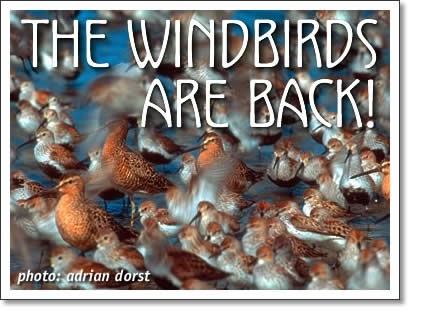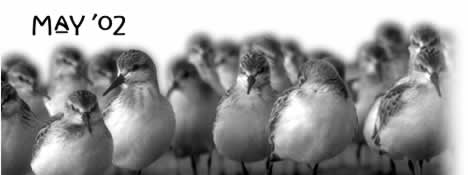
Tofino birding: The Windbirds are Back!
by Adrian Dorst, Tofino
Over the past decade and a half, Tofino has become widely known as a destination to observe Gray Whales in migration. Less well known is the fact that Tofino, situated as it is on the Pacific Flyway, is also an extraordinary place to observe a multitude of migratory birds. Tofino residents may become aware of this fact when, on soggy days in late March and early April, the village green may literally be covered by American Robins as they cock their heads in search of worms. Or when, in late April or early May, after an incoming storm front abruptly obscures the night sky, we suddenly see hordes of Golden-crowned Sparrows descending on the young, tender plants in our gardens. Birders call these inundations "fallout." What gardeners call the birds is probably best left unsaid.Among the most obvious migrants in Tofino are shorebirds, also known as waders. Beginning in early April, the vanguard of the migration begins to trickle in, with small groups of Greater Yellowlegs leading the pack. By the third or fourth week of April the migration begins in earnest. Then, large flocks of Western Sandpipers and Dowitchers arrive from Mexico, Central America, and Ecuador, while their Whimbrel cousins wing here from as far away as Chile.
Whenever possible, these birds take advantage of favourable winds. It's why Peter Mathieson referred to shorebirds as "the wind birds," which became the title of his book. One Western Sandpiper carrying a minute radio transmitter, and undoubtedly taking advantage of a south-easterly storm, flew from San Francisco to the Copper River delta in Alaska in under 3 days, a distance of 3,000 kilometers. This bird obviously did not stop in at Tofino for the usual 3 days of R&R. Most Westerns, however, drop in to replenish their stores of fat by feeding on beaches and mudflats along the route at places such as San Francisco, Coos Bay Oregon, Willapa Bay and Grays Harbor, Washington, as well as Tofino and Boundary Bay in the lower mainland.
Each spring, several million shorebirds stop at Boundary Bay in the Lower Mainland. In Tofino the numbers are considerably less, with perhaps 200,000 birds passing through. At the peak of the season, clouds of up to 20,000 birds may be seen in the area between Sharp Road and Jensen's Bay. But Tofino has the advantage over Boundary Bay in both variety of species, and easy accessibility. Sit quietly on the grass in a tidal meadow, and waders of up to a dozen species may feed in close proximity, some approaching within 20 or 30 feet.
Tofino also hosts several birds rarely seen at Boundary Bay. Flocks of up to a 150 Whimbrels, a type of Curlew, may be seen probing for ghost shrimp on exposed mudflats. And in recent years, similar-sized Godwits with long upturned bills have been showing up with increasing frequency. This is probably due to the fact that this prairie nester has expanded its range into Alaska, where its population is now increasing. Over 40 species of shorebirds have been recorded in our area, with 30 of those occurring regularly.
Expect to see up to a dozen varieties on the Tofino mudflats on an average day. If you are lucky, you may also enjoy the spectacle of a Peregrine Falcon, or its smaller cousin the Merlin, swooping in on a flock in a surprise attack. Prepare to be astounded at the sight of 20,000 wings flashing silver as the birds swoop and turn as one like an animated cloud. Optimum time for observing the migrants in Tofino varies but is generally the first two weeks in May. Western Sandpipers usually peak during the first week in May, so don't wait too long. Whimbrel numbers peak about mid May or soon thereafter.
Adrian Dorst is a Tofino nature photographer, carver, and birdwatching guide. His photos can be found in our photo gallery or on Adrian's website at www.adriandorst.com.
tofino | tofino time | activities | accommodation | events | directory
maps | travel | food | art & artists | photos | horoscope | tides
search | magazine | issues | articles | advertising | contact us
hosted in tofino by tofino.net & studio tofino
© 2002-2014 copyright Tofino Time Magazine in Tofino Canada

Tofino, situated on the Pacific Flyway, is an extraordinary place to observe migratory birds. Windbirds article by Adrian Dorst

